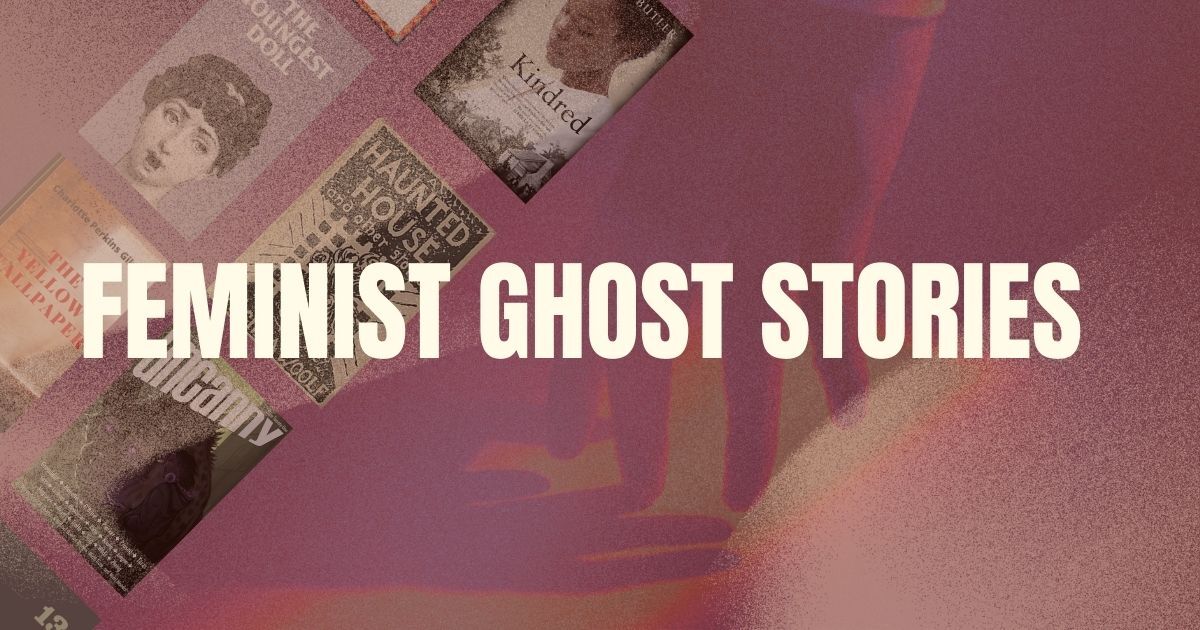One of the most popular genres in film and literature today is thriller, and for good reason. Feeling our emotions sharpen in excitement, anticipation, and anxiety, we’re gripped by the story unfolding in front of us. Then, as the story reaches its climax, we’re struck by the realization of humans’ reactions, society’s expectations, and the sublime unknown. Yes, this is a horror movie. Yes, this is a ghost story shared around the campfire. Yes, this is the latest thriller novel. Yet, it haunts us as we see the horrors suppressed in everyday life come alive in a blunt, irrevocable manner.
In celebration of the launching of Issue 46.3: Ghosts, we’ve gathered ten feminist ghost story recommendations we suggest you read (lest they haunt you tomorrow).
- “A Haunted House” by Virginia Woolf (The Hogarth Press, 1921). Both a ghost story and not a ghost story, this short story twists the conventions of a “ghost story.” The narrator describes her day-to-day life, seeing “a ghostly couple” wandering her house in search of something. As the ghosts go about the house, there’s a tender sadness that trails behind them that depicts the narrator’s struggle: “from the deepest wells of silence the wood pigeon drew its bubble of sound.” —Melissa Barrientos
- “We, the Girls Who Did Not Make It” by E. A. Petricone (Nightmare Magazine, 2021). This subversive short story has left a lasting imprint on me since the moment I first read it. Petricone challenges conventional narratives about true crime by telling this story from the perspective of thirteen girls murdered by a pair of cousins. This is a story that doesn’t shy away from the aftermath of violence and the loss that accompanies it. Yet, at its core, this is also a story about resilience and the enduring strength of those whose voices have been stifled. —Eleni Vlahiotis
- “The Youngest Doll” by Rosario Ferré (University of Nebraska Press, 1991). One of my favourite magical realism stories, “The Youngest Doll” follows an aunt, victimized in her youth, as she makes beautiful life-sized dolls for her nieces each time they marry. There’s a type of ancestral haunting on each page; the aunt’s unexpected and magical talent for making life-sized dolls hardened from the same brutality that harmed her in her youth becomes the needed change. —Melissa Barrientos
- The novel Kindred (Beacon Press, 2004) by Octavia Butler definitely belongs on the list, and I love that book, but it’s her short story “Bloodchild” (Seven Stories Press, 2005) that I will think about at random moments and shiver to imagine humanity surviving alongside these insect-like aliens who rely on human bodies. —Rachel Thompson
- The allegory “The Ones Who Walk Away from Omelas” by Ursula K. LeGuin haunts me in a different way, reflecting the horror of our own society. People with everything have it all because of the suffering of others. —Rachel Thompson
- “The Yellow Wallpaper” by Charlotte Perkins Gilman (The New England Magazine, 1892). After being told to just rest after a “temporary nervous depression—a slight hysterical tendency” by her husband and physician, the protagonist is confined to her house and eventually starts to see a woman trapped inside the yellow wallpaper. Marginalization of women, suppression of mental illnesses, and lack of autonomy are all concepts that haunt the edges of this story. —Melissa Barrientos
- “Every One of My Answers Was a Disappointment” by Doretta Lau was published in the Short Story Advent Calendar. It’s definitely a ghost story, but it’s also very funny. I also love how Doretta shared the story behind the story and that this was a story that took a while to find a home, but she didn’t give up. —Rachel Thompson
- “Meneseteung” by Alice Munro (The New Yorker, 1988). Using fragments of a life left behind, the narrator brings a woman back to life through local newspaper snippets, cemetery visits, and microfilm studying. As the narrator “put things together” in a literary Frankensteinian manner, memory—or imagined memory—is brought into question. —Melissa Barrientos
- “Old Habits” by Nalo Hopkinson is a great ghost story by a great fantasy writer, in which the narrator immediately tells us he is dead. —Rachel Thompson
- From the moment Amy shows up at brunch dead, I’m there. Room’s 2017 contest honourable mention-winning story “Dead Amy” by Michelle Kelm. —Rachel Thompson














